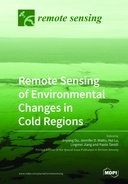Explore

Remote Sensing of Environmental Changes in Cold Regions
0 Ungluers have
Faved this Work
Login to Fave
This Special Issue gathers papers reporting recent advances in the remote sensing of cold regions. It includes contributions presenting improvements in modeling microwave emissions from snow, assessment of satellite-based sea ice concentration products, satellite monitoring of ice jam and glacier lake outburst floods, satellite mapping of snow depth and soil freeze/thaw states, near-nadir interferometric imaging of surface water bodies, and remote sensing-based assessment of high arctic lake environment and vegetation recovery from wildfire disturbances in Alaska. A comprehensive review is presented to summarize the achievements, challenges, and opportunities of cold land remote sensing.
This book is included in DOAB.
Why read this book? Have your say.
You must be logged in to comment.
Rights Information
Are you the author or publisher of this work? If so, you can claim it as yours by registering as an Unglue.it rights holder.Downloads
This work has been downloaded 280 times via unglue.it ebook links.
- 99 - pdf (CC BY-NC-ND) at Unglue.it.
Keywords
- aerial photographs
- Alaska
- antarctica
- Arctic navigation
- Arctic wetlands
- Athabasca River
- China
- Climate Change
- cryosphere
- decomposition
- desiccation
- elevation
- Everest
- Fort McMurray
- Frozen soil
- FY-3D/MWRI
- glacial lake
- global change
- ground-based radiometer
- Himalaya
- ice run
- L-band emission
- lake
- Landsat
- microwave radiation response depth (MRRD)
- microwave radiometer experiment
- MODIS
- n/a
- near-nadir SAR
- northern high latitudes
- parameterized model
- passive microwave
- protected areas
- Qinghai–Tibet Plateau
- RADARSAT-2
- Reference, information & interdisciplinary subjects
- regional algorithms
- Remote sensing
- Research & information: general
- sea ice concentration
- shipborne observation
- Snow
- snow depth
- supraglacial pond
- Tian Gong 2
- Tibetan Plateau
- tundra ponds
- WALOMIS
- Wetlands
- wildfire
Links
DOI: 10.3390/books978-3-03921-571-3Editions


